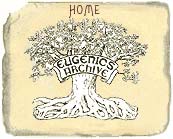
Traits Studied By Eugenicists
Jan Witkowski, Cold Spring Harbor Laboratory
In the early 20th century, Charles Davenport was prominent among American biologists as director of three institutions based at Cold Spring Harbor – the Eugenics Record Office (ERO), the Biological Laboratory, and the Carnegie Institute of Washington's Station for Experimental Evolution. Although initially skeptical of the wide applicability of Mendel's work, Davenport soon became an enthusiast and developed an early interest in the application of Mendel's laws to human beings. He noted in his 1909 Annual Report that the inability to conduct controlled experiments ruled out human genetics as a suitable topic for the Station for Experimental Evolution. Nevertheless, "the necessity of applying new knowledge to human affairs has been too evident to permit us to overlook it."
Davenport and his wife, Gertrude, published four papers between 1907 and 1910 that applied Mendelian principles to the human inheritance of eye color, hair color, hair texture and pigmentation. These were respectable studies, and the paper on skin pigmentation made the first reference to polygenic inheritance – a trait influenced by two or more genes. However, these papers also had methodological problems that foreshadowed later criticisms of eugenics research. For example, the eye color paper relied on data supplied by "school principals and other friends." Difficulties arose during data analysis, because of ambiguity in the varied descriptions of discrete eye coloration supplied by such a variety of collaborators. This became a much more serious problem when Davenport and other eugenicists moved on to study traits requiring even a greater degree of subjective assessment.
Davenport and other eugenicists were also interested in inherited disorders with clearly defined phenotypes and, often, straightforward modes of inheritance that could be deduced from the patterns of inheritance within families. These included alkaptonuria, hemophilia, ataxia, Huntington's chorea and albinism – as well as striking skeletal traits such as brachydactyly and polydactyly. Eugenicists also studied psychiatric disorders that appeared to be inherited – including feeble-mindedness, manic depression, and dementia praecox (schizophrenia). A chapter on human genetics in Reginald Punnett's book, Mendelism (1911), described the Mendelian inheritance of brachydactyly, hemophilia, and color blindness. However, Punnett acknowledged how difficult it is to study the inheritance of intelligence and other behavioral characteristics, which eugenicists believed had the greatest impact on society.
Francis Galton had aroused interest in the inheritance of behavioral traits in his book Studies of Hereditary Genius (1869), which purported to show a high proportion of eminent men in aristocratic British families. The publication of Davenport's The Trait Book, in 1912, did much to popularize the search for behavioral traits. Davenport's book was a systematic compilation of both genetic disorders and supposedly inherited characteristics that were to be recorded by field workers sent out by the ERO. Davenport was more egalitarian in this approach than Galton, although many of the special abilities he included in The Trait Book reflected his own middle class – such as elocution, drawing, musical composition, and golf. Personality traits were usually presented in contrasting pairs, with one member of each clearly carrying moral approval – politeness versus bluntness, self-sacrifice versus selfishness, and obedience versus disobedience. In most cases, eugenicists did not actually document any genetic contribution to such special abilities. However, Davenport did publish a study of naval officers, who purportedly shared a "sex-limited" (x-linked) gene for thalassophilia, "love of the sea."
These studies were of little significance to the practical goal of protecting the "American" germ plasm. Desirable traits, even if inherited, could only be spread slowly through directed marriages of "worthy" individuals. Much more promising was the possibility of preventing the further spread of undesirable characteristics. For example, shiftlessness was believed to be one of the inherited traits that contributed to pauperism, the tendency to be poor. Eugenicists reported that two shiftless parents produced virtually all shiftless children; the marriage of a shiftless and an industrious person produced about 10% shiftless offspring. Similarly, eugenicists assumed that there were inherited tendencies to alcoholism, sexual immorality, and feeblemindedness that contributed to "criminality."
Eugenicists identified "good blood" amongst the early settlers of North America, who came mainly from northern and western Europe. Their genes contributed to New England's "reputation for conscientiousness and love of learning and culture." However, eugenicists believed that recent immigrants from southern and eastern Europe had less desirable traits. So, while Germans as a rule were "thrifty, intelligent and honest," Italians had a "tendency to personal violence." Such comparisons led to the inescapable conclusion that unrestricted immigration would lead to the degeneration of American germ plasm. By linking undesirable traits with specific racial and ethnic groups, eugenicists scored a significant impact on social policy with the passage of restrictive immigration laws in the 1920s.
Davenport and his contemporaries failed to recognize that not all familial traits are biologically inherited, and that even traits that are inherited can have complex causes. This, coupled with an evangelical commitment to create a society molded in their own image, led the eugenicists to make simplistic and unsupportable claims about human heredity. Punnett made an early indictment of the methods during a presentation at the First International Congress on Eugenics in 1911 – the year The Trait Book was published: "Except in very few cases, our knowledge of heredity in man is at present far too slight and too uncertain to base legislation upon…It must be clearly recognized that the collection of such [accurate] pedigrees is an arduous undertaking demanding high critical ability…"
The same inherited disorders studied by the eugenicists continue to occupy modern clinical geneticists. Causative genes have been isolated for about 40 disorders with straightforward Mendelian inheritance, making possible DNA-based diagnosis. Most complex behavioral disorders, such as schizophrenia and manic depression, are hardly better understood today than in Davenport's time.
